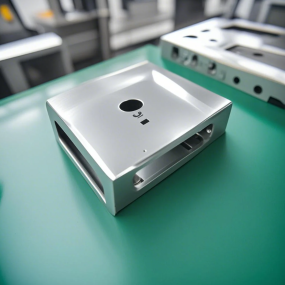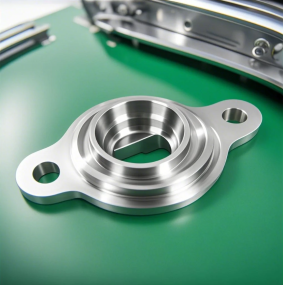Numerical control five-axis machining is a complex machining technology that requires the operator to have professional skills and experience. For parts that need to be machined with complex geometries, five-axis machining is undoubtedly a very effective machining method. The improvement of numerical control five-axis machining efficiency can be achieved through the following aspects: Optimizing the tool path: The optimization of the tool path is the key to improving the machining efficiency. Adopting more efficient machining strategies and advanced CAM software can reduce the empty travel of the tool, reduce the energy consumption of the cutting process, and improve the stability of the machining process. At the same time, according to the structural characteristics of specific parts, fine tool path planning can also significantly improve the machining efficiency.  Selection of high-performance tool materials: In the selection of tool materials used in numerical control machine tools, high-performance tool materials should be selected as much as possible. High-performance tool materials have higher durability and better cutting performance, which can reduce the probability of tool wear and damage, reduce the auxiliary time of tool change and sharpening, thereby improving the processing efficiency. Application of indexable tools: The structure of modern various tools is basically indexable tools. Indexable tools have the advantages of fast blade change, reasonable tool geometry parameters and chip breaking groove. At the same time, many advanced processes (such as various coatings, etc.) are used to multiply the tool durability and anti-bonding wear, which greatly saves the auxiliary time of tool change for sharpening, thereby improving the processing efficiency. Reasonable selection of cutting dosage: The cutting dosage is an important factor affecting the processing efficiency. In the three elements of cutting dosage (cutting speed, feed and cutting depth), the value of each element is increased by 1 times, and the processing efficiency is nearly doubled. In the cutting speed range, the cutting effect, tool durability and processing cost are the most reasonable. Therefore, in the specific machining process, the cutting dosage should be reasonably selected according to the performance of the workpiece material and tool material. Selection of reasonable cutting fluid: Cutting fluid plays an important role in improving cutting efficiency and affecting the success or failure of cutting processing. The selection of reasonable cutting fluid can improve cutting speed, improve tool durability and prevent the generation of chip accumulation, thereby further improving processing efficiency. Optimization of machine tool parameters: The optimization of machine tool parameters is also an important means to improve processing efficiency. For example, by adjusting the spindle speed, feed speed and other parameters, the processing efficiency can be improved under the premise of ensuring the processing quality. At the same time, according to different processing needs, suitable machine tool accessories and tools can also be selected, such as high-efficiency fixtures, quick tool change systems, etc., to further improve the processing efficiency. Improve the skill level of operators: The skill level of operators also has an important impact on the processing efficiency. Through training and skill improvement, operators can be more familiar with the performance characteristics of machine tools and tools, master more fine cutting skills, so as to better play the performance advantages of machine tools and tools in the specific processing process and improve the processing efficiency. To sum up, the improvement of numerical control five-axis machining efficiency needs to start from multiple aspects.
Selection of high-performance tool materials: In the selection of tool materials used in numerical control machine tools, high-performance tool materials should be selected as much as possible. High-performance tool materials have higher durability and better cutting performance, which can reduce the probability of tool wear and damage, reduce the auxiliary time of tool change and sharpening, thereby improving the processing efficiency. Application of indexable tools: The structure of modern various tools is basically indexable tools. Indexable tools have the advantages of fast blade change, reasonable tool geometry parameters and chip breaking groove. At the same time, many advanced processes (such as various coatings, etc.) are used to multiply the tool durability and anti-bonding wear, which greatly saves the auxiliary time of tool change for sharpening, thereby improving the processing efficiency. Reasonable selection of cutting dosage: The cutting dosage is an important factor affecting the processing efficiency. In the three elements of cutting dosage (cutting speed, feed and cutting depth), the value of each element is increased by 1 times, and the processing efficiency is nearly doubled. In the cutting speed range, the cutting effect, tool durability and processing cost are the most reasonable. Therefore, in the specific machining process, the cutting dosage should be reasonably selected according to the performance of the workpiece material and tool material. Selection of reasonable cutting fluid: Cutting fluid plays an important role in improving cutting efficiency and affecting the success or failure of cutting processing. The selection of reasonable cutting fluid can improve cutting speed, improve tool durability and prevent the generation of chip accumulation, thereby further improving processing efficiency. Optimization of machine tool parameters: The optimization of machine tool parameters is also an important means to improve processing efficiency. For example, by adjusting the spindle speed, feed speed and other parameters, the processing efficiency can be improved under the premise of ensuring the processing quality. At the same time, according to different processing needs, suitable machine tool accessories and tools can also be selected, such as high-efficiency fixtures, quick tool change systems, etc., to further improve the processing efficiency. Improve the skill level of operators: The skill level of operators also has an important impact on the processing efficiency. Through training and skill improvement, operators can be more familiar with the performance characteristics of machine tools and tools, master more fine cutting skills, so as to better play the performance advantages of machine tools and tools in the specific processing process and improve the processing efficiency. To sum up, the improvement of numerical control five-axis machining efficiency needs to start from multiple aspects.
Hello! Welcome to EMAR's website!
 English
English » »
» »
 Spanish
Spanish Arabic
Arabic French
French Portuguese
Portuguese Belarusian
Belarusian Japanese
Japanese Russian
Russian Malay
Malay Icelandic
Icelandic Bulgarian
Bulgarian Azerbaijani
Azerbaijani Estonian
Estonian Irish
Irish Polish
Polish Persian
Persian Boolean
Boolean Danish
Danish German
German Filipino
Filipino Finnish
Finnish Korean
Korean Dutch
Dutch Galician
Galician Catalan
Catalan Czech
Czech Croatian
Croatian Latin
Latin Latvian
Latvian Romanian
Romanian Maltese
Maltese Macedonian
Macedonian Norwegian
Norwegian Swedish
Swedish Serbian
Serbian Slovak
Slovak Slovenian
Slovenian Swahili
Swahili Thai
Thai Turkish
Turkish Welsh
Welsh Urdu
Urdu Ukrainian
Ukrainian Greek
Greek Hungarian
Hungarian Italian
Italian Yiddish
Yiddish Indonesian
Indonesian Vietnamese
Vietnamese Haitian Creole
Haitian Creole Spanish Basque
Spanish Basque












